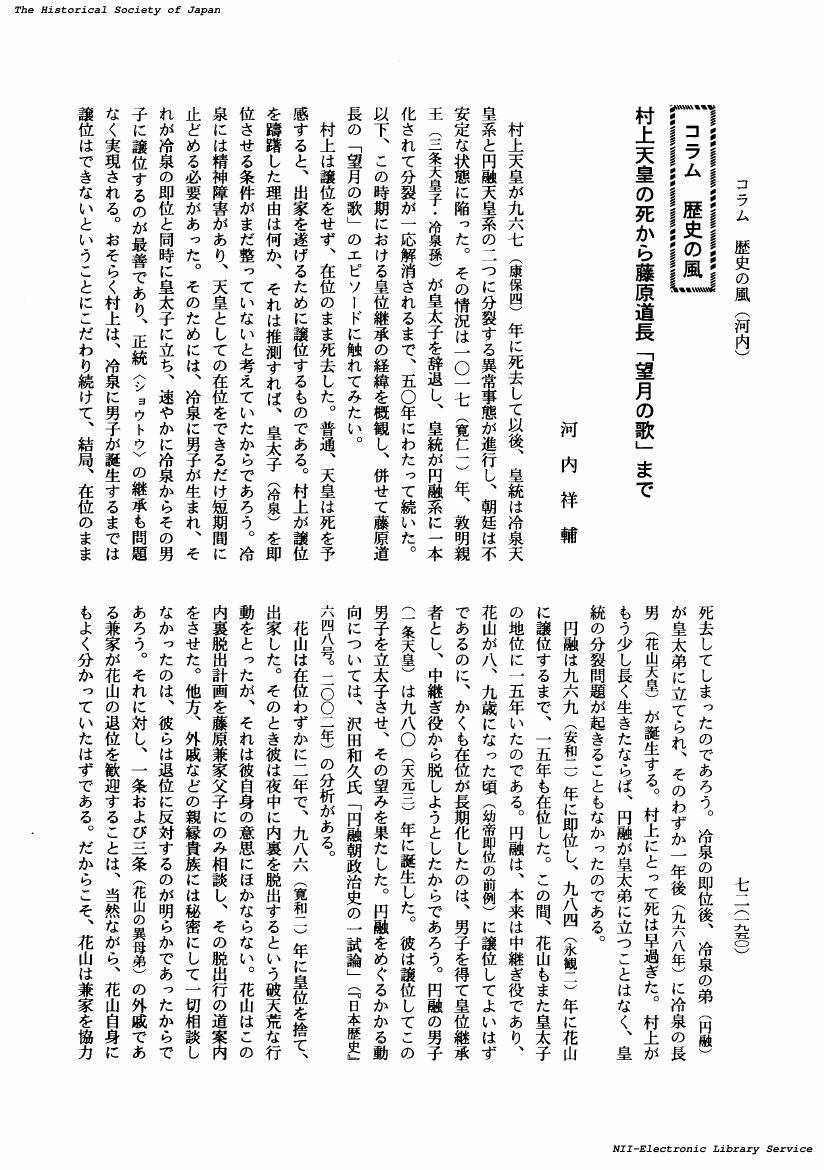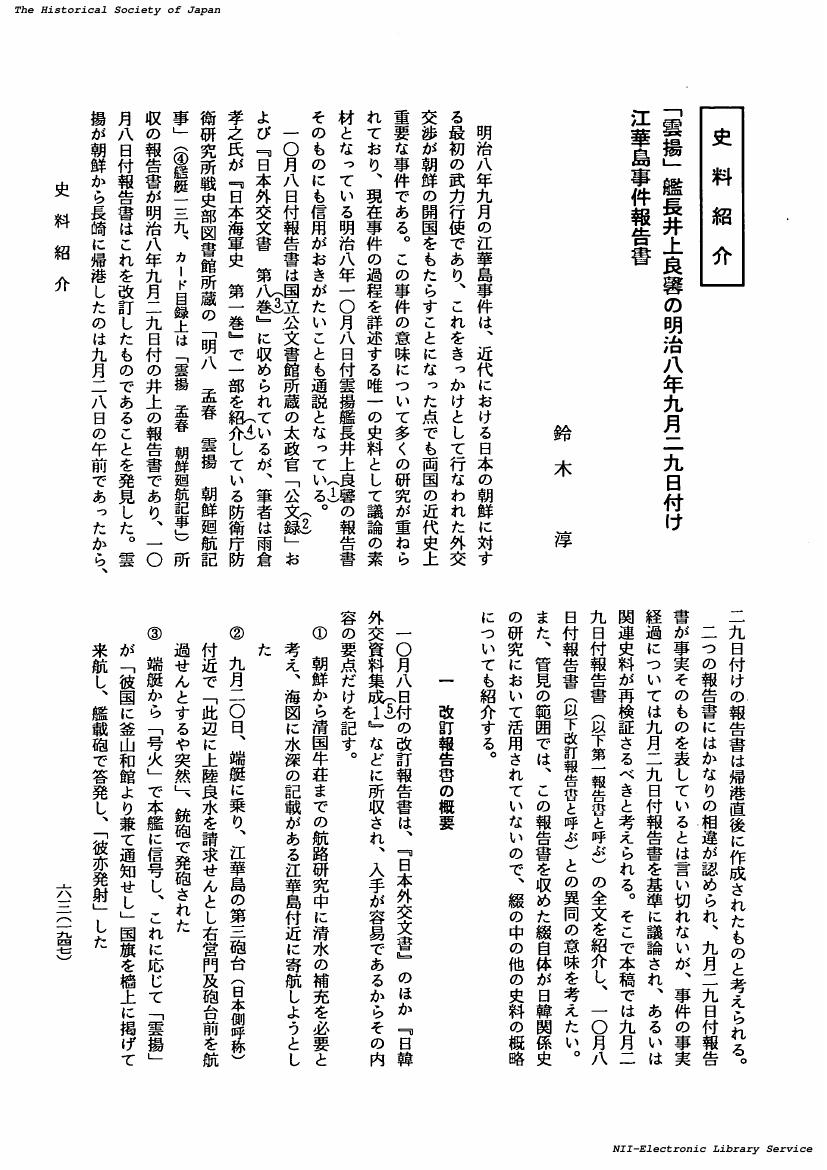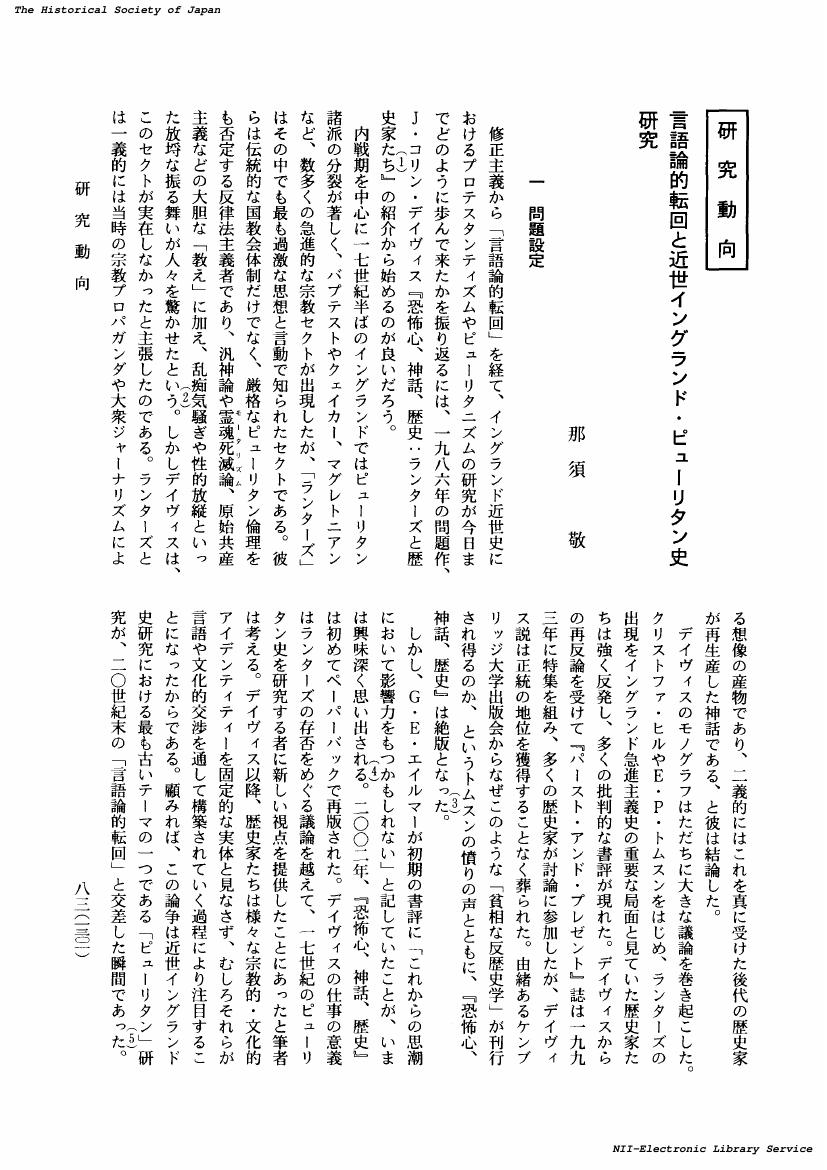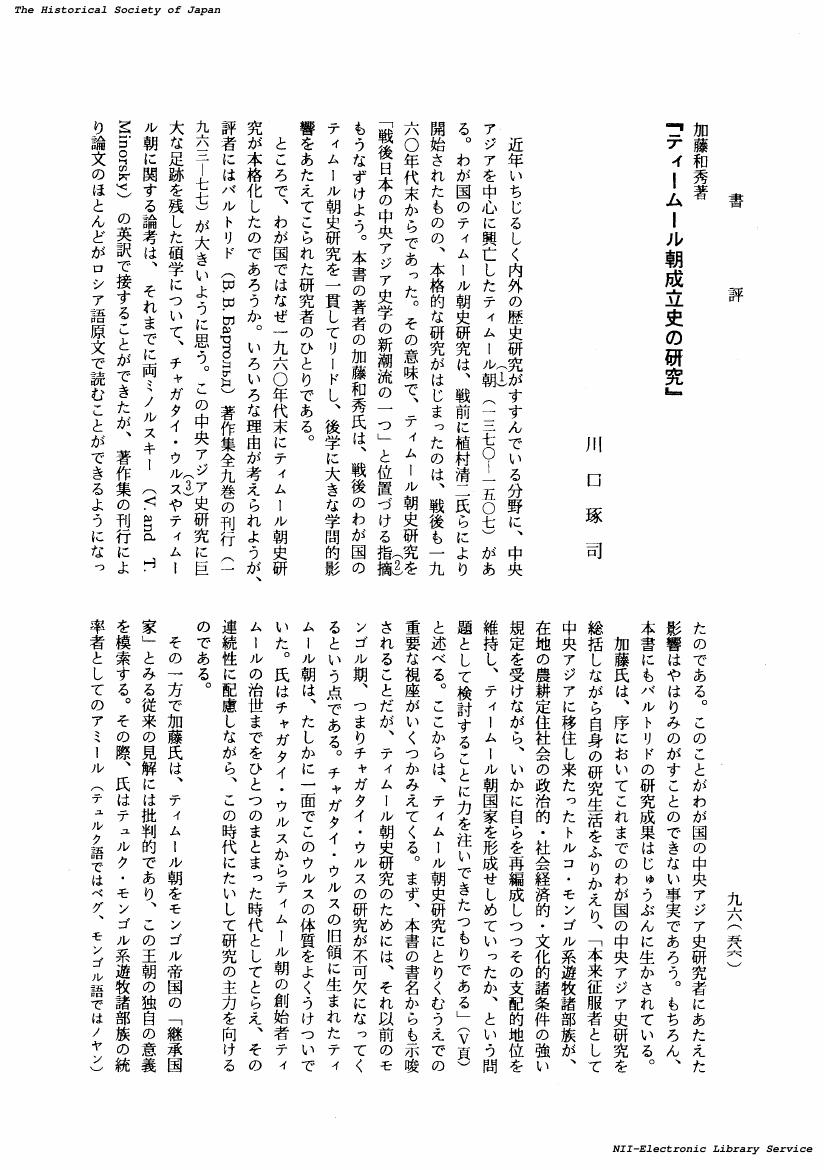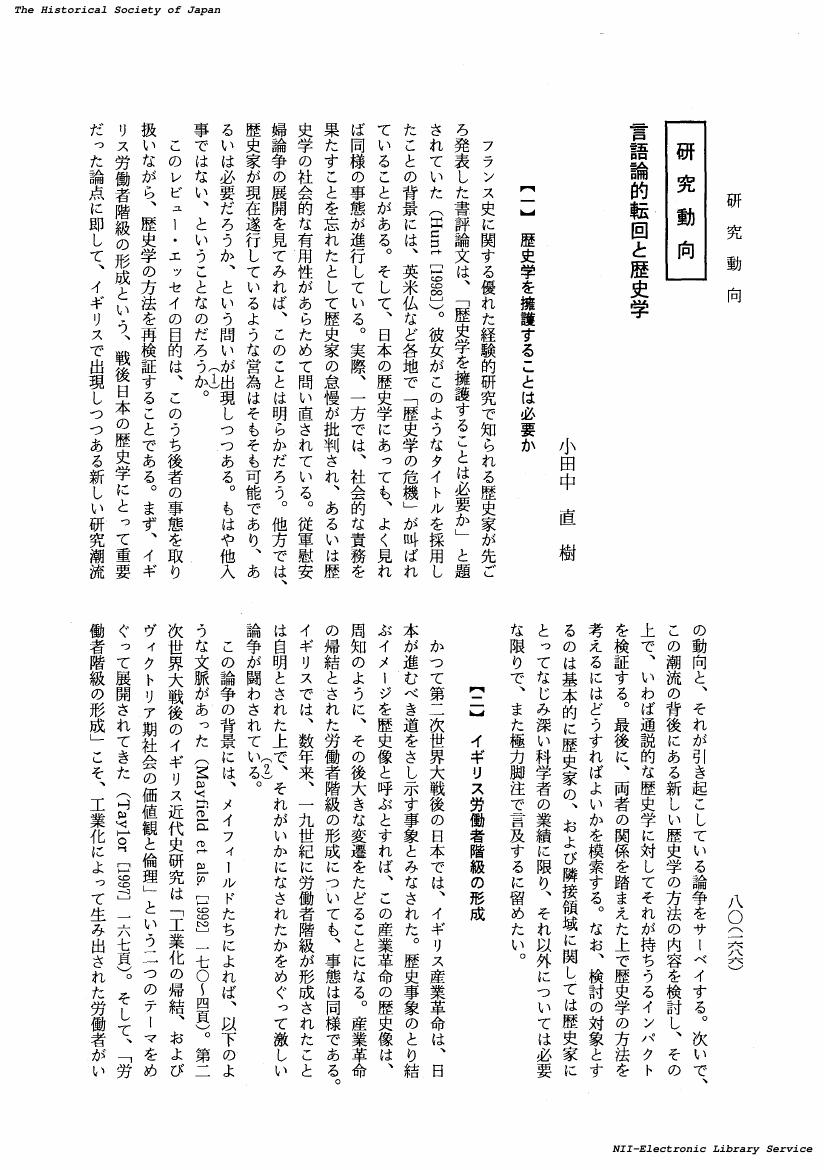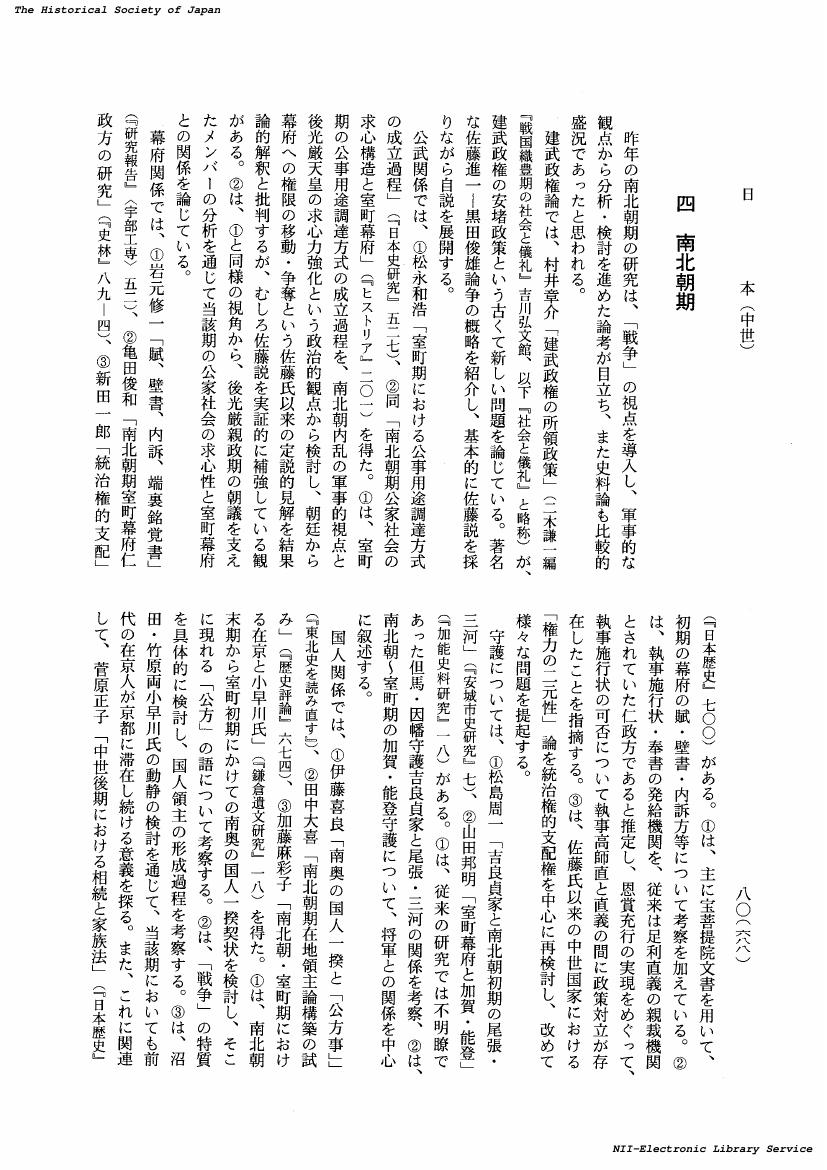238 0 0 0 OA 萩原淳平著『明代蒙古史研究』(東洋史研究叢刊之三十二)
- 著者
- 岡田 英弘
- 出版者
- 公益財団法人 史学会
- 雑誌
- 史学雑誌 (ISSN:00182478)
- 巻号頁・発行日
- vol.90, no.8, pp.1281-1287, 1981-08-20 (Released:2017-10-05)
164 0 0 0 OA 戦後日本の公葬 国葬の変容を中心として
- 著者
- 前田 修輔
- 出版者
- 公益財団法人 史学会
- 雑誌
- 史学雑誌 (ISSN:00182478)
- 巻号頁・発行日
- vol.130, no.7, pp.61-82, 2021 (Released:2022-07-20)
国家の栄典たる国葬は、戦前の20例に対し、戦後は1例のみにとどまり、代わって国民葬や内閣・自由民主党合同葬儀などの形が登場した。この展開は何によりもたらされたのか。本稿は、昭和42年の吉田茂国葬、昭和50年の佐藤栄作国民葬、昭和55年の大平正芳内閣・自由民主党合同葬儀の3例を検討対象とし、国家勲功者に対して内閣が主体となり執り行われる公葬と、それを取り巻く問題から、戦後日本の国家における顕彰・追悼の姿を検討するものである。 吉田の国葬に際し、宗教的形式の採用によって政教分離への批判をおそれた政府は、国葬から宗教色を排除する。そのため、明治以来、神道式で行われてきた儀式の連続性が途絶え、新たな形式が登場する。またこれは閣議決定により実施された。だが日本国憲法下で、この「国家による葬儀」の決定過程に議会が参画しないことに対する批判が湧き上がる。さらに佐藤が国葬とされなかったことは、権衡の関係から国葬該当者の不在を招いた。加えて、過去に法的根拠が存在したという事実が重要視されるようになった結果、国葬から国民葬や合同葬へと移行した。 また、吉田の国葬では、政府側が国民の協力を求め、メディア側もこれに自主的・積極的に協力した。しかし、国民全体で偉勲者の死を悼むには至らず、政府やメディアへの批判も生じてしまう。そのため、その後の公葬は国民の参画規模が縮小し、メディア側の姿勢も消極的となる。 公費による首相経験者の顕彰は、時の政権の正当性の主張にもつながる行為であり、また遺された者にとって政治的な意味をもつこともある。よって、政府・与党が顕彰するに足る人物だと判断されたからこそ公葬が行われるのであり、その中心的な要素は国葬から合同葬に継承されていると結論づけた。
135 0 0 0 OA 田中 浩著『ホッブズ研究序説-近代国家論の生誕-』
- 著者
- 水田 洋
- 出版者
- 公益財団法人 史学会
- 雑誌
- 史学雑誌 (ISSN:00182478)
- 巻号頁・発行日
- vol.92, no.3, pp.377-384, 1983-03-20 (Released:2017-11-29)
89 0 0 0 OA 村上天皇の死から藤原道長「望月の歌」まで(コラム歴史の風)
- 著者
- 河内 祥輔
- 出版者
- 公益財団法人 史学会
- 雑誌
- 史学雑誌 (ISSN:00182478)
- 巻号頁・発行日
- vol.117, no.11, pp.1950-1952, 2008-11-20 (Released:2017-12-01)
72 0 0 0 OA 中国明清史料収集活動史(コラム 歴史の風)
- 著者
- 山本 英史
- 出版者
- 公益財団法人 史学会
- 雑誌
- 史学雑誌 (ISSN:00182478)
- 巻号頁・発行日
- vol.123, no.9, pp.1641-1643, 2014-09-20 (Released:2017-07-31)
62 0 0 0 OA 「島のケルト」再考
- 著者
- 田中 美穂
- 出版者
- 公益財団法人 史学会
- 雑誌
- 史学雑誌 (ISSN:00182478)
- 巻号頁・発行日
- vol.111, no.10, pp.1646-1668, 2002-10-20 (Released:2017-12-01)
61 0 0 0 OA 「雲揚」艦長井上良馨の明治八年九月二九日付け江華島事件報告書
- 著者
- 鈴木 淳
- 出版者
- 公益財団法人 史学会
- 雑誌
- 史学雑誌 (ISSN:00182478)
- 巻号頁・発行日
- vol.111, no.12, pp.1947-1957, 2002-12-20 (Released:2017-12-01)
50 0 0 0 OA 一九〇一年のドイツへの清朝「謝罪使」の派遣 : 「謝罪使」観と謁見儀礼問題を中心に
- 著者
- 小池 求
- 出版者
- 公益財団法人 史学会
- 雑誌
- 史学雑誌 (ISSN:00182478)
- 巻号頁・発行日
- vol.118, no.9, pp.1620-1643, 2009-09-20 (Released:2017-12-01)
As one condition of the program instituted under the Boxer Protocol of 7 September 1901, the emperor of China was required to make a formal apology to the emperor of Germany for the murder of Baron von Ketteler in Beijing during the Boxer uprising. However, the Qing Dynasty's decision to send a mission of expiation to Germany was motivated less by the rules of the Protocol than an intention to improve relations between the two countries, while Germany's main intent was to receive a formal apology for Ketteler's murder. This divergence in expectations would greatly complicate negotiations over how the audience between the Chinese ambassador and the German emperor was to be conducted and cause increased friction between the two countries. The problems concerning the audience decorum involved 1) the submission of an official communique, which Prince Chun 醇 was to perform in the presence of Wilhelm II and 2) the German demand that the Chinese "kowtow" at the emperor's feet as a sign of apology. The Chinese vehemently protested the demand to "kowtow" as an act of "national disgrace." As the negotiations bogged down, the original Chinese expectations about the mission were dashed. The Qing government desired the use of a precedent established in 1896 when Li Hongzhang 李鴻章 was granted an audience before Wilhelm II and submitted to him a formal letter; but the German emperor insisted that Prince Chun's Chinese retinue kowtow, despite initial opposition by his own Bureau of Foreign Affairs. Upon the advice of diplomats who had directly experienced life at the Qing Court, the Bureau argued that since the kowtow was a religious act, it was inappropriate within the realm of international diplomacy, showing that there were concerned parties in both countries who were willing to compromise via diplomatic precedents and interpretations. Wilhelm II did heed the criticism offered by his diplomats and public opinion, showing a disposition to compromise, but giving into such pressure also threatened to demean his imperial authority. Therefore, resolving the "kowtow problem" required some gesture from the Chinese, which appeared in the form of a prodigious appeal to the emperor from Prince Chun to graciously excuse his Chinese retinue from kowtowing, which freed the Germans to relent without any loss of face on the part of their emperor. It was in this way that through a compromise between the two countries on the question of diplomatic ceremony, the problems surrounding the mission of expiation were solved prior to the signing of the Boxer Protocol.
44 0 0 0 禅宗の祈祷と室町幕府 : 三つの祈祷システム
- 著者
- 細川 武稔
- 出版者
- 公益財団法人史学会
- 雑誌
- 史學雜誌 (ISSN:00182478)
- 巻号頁・発行日
- vol.113, no.12, pp.2004-2024, 2004-12-20
The present article focuses on prayer rituals performed by temples of the Zen Sect in order to shed light on the relationship between that Sect and the Muromachi Bakufu and on the character of the mechanism of Bakufu-designated official temples (kanji 官寺), which tied the Zen sect, especially the five great temples of Kyoto (Gozan 五山), closely to the Bakufu. The author identifies three separate systems of prayer (kito 祈祷) : one centered on the kanji organization of the Gozan-Jissatsu-Shozan temple hierarchy, one made up of Bakufu-designated "prayer temples" (kiganji 祈願寺) and one centered around the Ashikaga family temple of Shokokuji 相国寺. At the time of the founding of the Bakufu, the kanji temples of Kyoto were ordered to conduct prayer rituals, but no preparation was made at that time to have similar rituals conducted in the provinces. The shoguns issued directives recognizing temples as kiganji to supplement the kanji organization ; and later these temples were gradually absorbed into the kanji hierarchy as they spread throughout the country, being perceived as the system of prayer for the unified aristocrat-warrior Muromachi regime. However, this prayer order went through tremendous change with the building of Shokokuji by the third shogun, Yoshimitsu, as Zen priests of this Ashikaga family temple (bodaiji 菩提寺) were requested to perform prayer rituals in honor of the shogun's birthday, pray in the Kannon Room of the Shogun's residence, and conduct specially requested ceremonies. In other words, Shokokuji was preferred to such temples as Nanzenji 南禅寺 and Tenryuji 天龍寺, which were ranked above even the kanji hierarchy. Taking the leadership in the organization of the prayer system was the Inryoshiki 蔭涼職 (the shogun's major domo) in cooperation with the Rokuon-Soroku 鹿苑僧録, the registrar and supervisor of the kanji organization. Although Shokokuji developed into the nucleus of the three prayer systems, the kanji organization was indispensable due to its traditional ties to the public and state aspects of the imperial court, thus making it possible for two different systems to stand side-by-side, indicating how the Bakufu made the Zen Sect serve its purposes in both its public and private spheres.
43 0 0 0 日本 : 中世 五(一九八九年の歴史学界 : 回顧と展望)
- 著者
- 山室 恭子
- 出版者
- 公益財団法人 史学会
- 雑誌
- 史学雑誌 (ISSN:00182478)
- 巻号頁・発行日
- vol.99, no.5, pp.702-708, 1990
40 0 0 0 OA 足利一門再考 : 「足利的秩序」とその崩壊
- 著者
- 谷口 雄太
- 出版者
- 公益財団法人 史学会
- 雑誌
- 史学雑誌 (ISSN:00182478)
- 巻号頁・発行日
- vol.122, no.12, pp.2019-2042, 2013-12-20 (Released:2017-12-01)
This article addresses a number of questions about the Ashikaga Clan that have remained unclarified in the research to date: namely, Who made up that Clan? What is meant by the Ashikagas being as a "clan" (ichimon 一門) ? What does "the Ashikagas becoming a clan" mean? By reexaming these questions, the author hopes to better understand how the Ashikaga period came to a destructive end. The author begins by showing that the heretofore vaguely used term Ashikaga-shi Goikka 足利氏御一家 has been used in the two different senses of Ashikaga Gosanke (Three Branches of the Ashikaga Family) and Ashikaga Ichimon. And about the comment by the Tokis of the Sengoku period--After the Goikka, I am the leader of the all the other families, the author shows that "Goikka" means Ashikaga Ichimon. Secondly, the author reexamines the similarly vague term "Ashikaga Ichimon" by identifying its members from the available medieval historiography. One characteristic feature that has not been noticed to date is that both the Nitta Branch of the Minamoto Clan and the Yoshimi Family were included among its members. In particular, 1) the Nittas regarded themselves as members from the very beginning, since the Ashikaga Clan was essentially part of "the Yoshikuni branch of the Minamoto Clan"; and 2) the perception that the Nittas did not consider themselves part of the Ashikaga Clan can be traced back to the exclusive self-identity "ware-ware 我々" consciousness described in the Taiheiki 太平記. Next, after stating that there is yet no piece of research that has tried to present the Ashikaga Clan in a holistic fashion, but should be, the author shows from the medieval historiography that the above-mentioned perception of the Tokis that the Ashikaga Clan surpassed in status and prestige all other warrior clans was universally widespread during the Ashikaga period. Finally, the author inquires as to why such families as the Miyoshis and Odas of the Sengoku Period tried to debunk and alter the above-mentioned perception of the Ashikaga Clan's superiority, concluding that it was necessary to first switch the prerequisite for "changing the system from above" from kinship (i.e., membership in the Ashikaga Clan) to actual organizational ability as one indispensable step in the destruction of the existing order.
38 0 0 0 OA 言語論的転回と近世イングランド・ピューリタン史研究
- 著者
- 那須 敬
- 出版者
- 公益財団法人 史学会
- 雑誌
- 史学雑誌 (ISSN:00182478)
- 巻号頁・発行日
- vol.117, no.7, pp.1301-1314, 2008-07-20 (Released:2017-12-01)
35 0 0 0 「雲揚」艦長井上良馨の明治八年九月二九日付け江華島事件報告書
- 著者
- 鈴木 淳
- 出版者
- 公益財団法人 史学会
- 雑誌
- 史学雑誌 (ISSN:00182478)
- 巻号頁・発行日
- vol.111, no.12, pp.1947-1957, 2002
- 著者
- 川口 琢司
- 出版者
- 公益財団法人 史学会
- 雑誌
- 史学雑誌 (ISSN:00182478)
- 巻号頁・発行日
- vol.109, no.4, pp.586-595, 2000-04-20 (Released:2017-11-30)
31 0 0 0 OA 言語論的転回と歴史学
- 著者
- 小田中 直樹
- 出版者
- 公益財団法人 史学会
- 雑誌
- 史学雑誌 (ISSN:00182478)
- 巻号頁・発行日
- vol.109, no.9, pp.1686-1706, 2000-09-20 (Released:2017-11-30)
31 0 0 0 オスマンとローマ : 近代バルカン史学史再考(研究動向)
- 著者
- 藤波 伸嘉
- 出版者
- 公益財団法人史学会
- 雑誌
- 史學雜誌 (ISSN:00182478)
- 巻号頁・発行日
- vol.122, no.6, pp.1083-1108, 2013-06-20
- 著者
- 一ノ瀬 俊也
- 出版者
- 公益財団法人 史学会
- 雑誌
- 史学雑誌 (ISSN:00182478)
- 巻号頁・発行日
- vol.112, no.8, pp.1370-1385, 2003
The intent of the present article is to analyze "histories" compiled by each regiment in the Japanese army from the Russo through the Sino-Japanese wars, concluding that such works were nothing the Sino-Japanese wars, concluding that such works were nothing but attempts to praise "the heroic past" and provide a means to instill such a consciousness in both the troops and society in general.The historical remembrances of the Russo-Japanese conflict were more and more emphasized with the outbreak of the First World War and the anti-war and anti-militarization movement that accompanied it.The descriptions of those who had died in past conflict were intended to stir the emotions of the troops and provide a route by which to legitimized "dying forons's country".Even on the local level during that time, "memorials to veterans" of both wars were compiled with the similar intention of establishing a forum upon which to instill a common sentiment about the viewpoints and logic of the military within local society.After the outbreak of the Manchurian Incident, "regimental histories" took on two distinct forms.The first consisted of memoirs concerning the victorious history of the Russo-and Sino-Japanese Wars, which in addition to insisting upon Japan's legitimate claim to Manchuria, tried to prove that even the Japanese people, who had not really experienced a genuine war since the Russo-Japanese conflict and had become used to peace, could indeed win another full-scale war, thus playing a role in attempts to instill"definite behavior patterns" and encourage the country's fighting spirit.The second contained contemporary regiment-by-regiment accounts of the Manchurina Incident told from the personal views of individual combatants with the intention of verifying the regiment's consciousness concerning the Incident, encouraging further sacrifices for the cause, and appsaling to society at large.The veteran memorial literature published on the local level at that time were compiled with a similar intent in mind, attempting like during World War I to instill military ideals and persuasive logic into society at large.
30 0 0 0 安丸良夫著『日本の近代化と民衆思想』
- 著者
- 沼田 哲
- 出版者
- 公益財団法人 史学会
- 雑誌
- 史学雑誌 (ISSN:00182478)
- 巻号頁・発行日
- vol.85, no.1, pp.75-84, 1976
29 0 0 0 OA 中世 四 南北朝期(日本,2006年の歴史学界-回顧と展望-)
- 著者
- 亀田 俊和
- 出版者
- 公益財団法人 史学会
- 雑誌
- 史学雑誌 (ISSN:00182478)
- 巻号頁・発行日
- vol.116, no.5, pp.688-690, 2007-05-20 (Released:2017-12-01)
29 0 0 0 村上天皇の死から藤原道長「望月の歌」まで(コラム歴史の風)
- 著者
- 河内 祥輔
- 出版者
- 公益財団法人史学会
- 雑誌
- 史學雜誌 (ISSN:00182478)
- 巻号頁・発行日
- vol.117, no.11, pp.1950-1952, 2008-11-20


